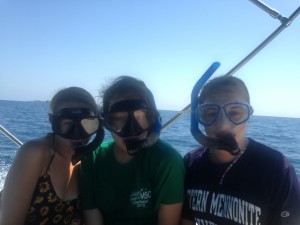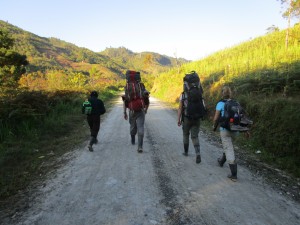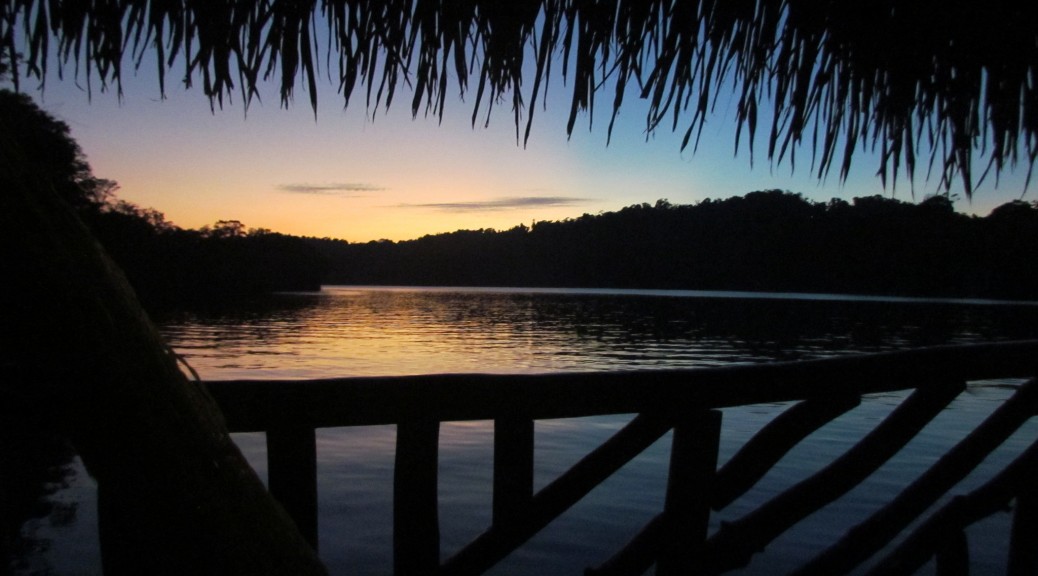Belize
Traveling can be many things, all at the same time: stressful, exciting, intimidating, life-giving, etc. For me, this past week touched on all of these things and many more. Our group was one of three that chose Belize as our final destination, but first we had to accept the challenges of getting there. We started with an early morning bus to Puerto Barrios, on the coast of Guatemala. After a late arrival came a hurried trip to catch a not-so-official looking boat to Punta Gorda, Belize. Another late arrival, and we managed to catch the bus towards Hopkins. The journey ended successfully with a four mile, hitched ride into town, hunkered down in the bed of a pick-up truck. The cabana that awaited us was seafront and serene. Palm trees, hammocks, sea water and salty air welcomed us to heaven. Throughout the week we would spend a lot of time enjoying all of these things, but we’d also learn quickly about what makes Belize so unique.
Lesson #1: People in Belize will be friendly and kind to anyone. There is no need for American caution if you want to get the fullest experience from this amazing place.
Lesson #2: It’s really ok, even recommended, to buy fresh fish off of a wooden table in the sand next to your house. Cleaning seems optional. Cooking is definitely not.
Lesson #3: One person’s dog is everybody’s dog. You can pet them and play with them, just don’t feed them.
Lesson #4: The sun truly is stronger near the equator; there is no such thing as taking sunscreen too seriously. Also don’t ever put Vaseline on sunburn. Especially not for three days in a row. It keeps the heat in and makes it worse, not better.
Lesson #5: Local kids will play with complete strangers, and that is totally ok. Enjoy the time you have to spend with them, even if they don’t yet speak your language.
Lesson #6: No matter how hard you try, salamanders will get into your house. But remember, they’re just as afraid of you as you are of them.
Lesson #7: Time is only a number. Don’t try to get things done too quickly…unless it’s transportation. Then it’s important to be an hour early for everything.
Lesson #8: Fruit in the back of a pick-up truck is 100% ripe, 100% fresh, and 100% delicious.
Lesson #9: Snorkeling is worth every penny. With water, reefs, and marine life like Belize has, I could easily have spent every day in those islands.
Lesson #10: There are 21 styles of Garifuna drumming. They may all sound the same, but trust me- they’re not.
We had an incredible week on a perfect beach in a gorgeous country. The time to return to Guatemala came far too quickly, but with us we brought back photos, souvenirs, seashells, and suntanned skin. The bus and boat rides returning to the city weren’t filled with stress or anxiety this time; instead they were filled with memories and thankfulness that we were blessed to experience a week of fun and friendship in one of the most welcoming and beautiful places in the world.
-Kate Harrold
Lake Atitlan
Gabby, Allie, Kevin, and Bethannie (the last two being the lovely writers of this post), all traveled to Lake Atitlan for our week of free travel. Lake Atitlan is located in the western part of Guatemala and is surrounded by many pueblos, the two most notable being Panajachel and Santiago. Panajachel is known for its many artisan markets which are biggest and craziest on Sundays. We visited some of these markets during our last day of free travel, though mostly when in Pana we frequented the food markets which sold a wide variety of fruits and vegetables, as well as nuts, eggs, rice, beans, and hot chocolate. Lake Atitlan is also notable for its wind patterns. The lake is always calm in the mornings, with barely a ripple in the water, but almost like clockwork, every day at 11 a.m., the winds come in and the water gets dangerously rough, usually not calming down until late in the evening. One final cool thing about the lake is the presence of an organic coffee plantation, something that is not easily found in Guatemala.
One of the things we all most enjoyed during free travel was cooking our own meals. We rented out a house on the lake shore with a full kitchen, and spent many hours creating delicious dishes. Fried plantains were something I mastered, making them nearly every day for lunch. We also had pancakes with fresh fruit, honey, syrup, peanut butter, and granola available as toppings every morning. Frequenting the food markets in Pana was a nice way for us to keep the yummy fruits and vegetables coming.
We rented a beautiful house not even 30 feet from the lake. Within the same property were two or three other smaller houses, each being rented out to other people. The tenant of one of these houses turned out to be a great friend and a great source of information on all things camping and backpacking, as well as information regarding the best ways to travel around the lake and the right prices to pay for the lanchas (boats that transport passengers from pueblo to pueblo). We shared some great conversation, and he even came to see us off on our final day.
We took a day to explore the closest pueblos to our house. By way of hiking along a mountain ridge and taking lanchas from dock to dock, we passed through two of the pueblos that surround Lake Atitlan. Here we got to see a bit of the local culture as well as got to visit a wonderful restaurant in a more touristy area. Overall it was a great time, a fun adventure, and an interesting chance to see the different ways we were perceived depending on where we were. The generally friendly and inviting Guatemalan people tended to shift between two extremes – clearly wanting you to leave their tiny village, or super happy to see you (because tourists always have money).
Another place that we visited was a nature reserve just outside of Panajachel that included a butterfly sanctuary. This was something that was meaningful especially for me (Bethannie). For many years I’ve had a phobia of all bugs, but have been working to overcome this irrational fear. I wanted to go to the butterfly reserve in particular because I thought it was a good next step in dealing with this fear. I turned out to be right. With much controlled, deep breathing, I was able to walk through the sanctuary as butterflies flew around me on all sides. At one point, I even felt brave enough to reach out and touch one butterfly that was resting on a leaf, though it flew away at my touch. This experience taught me to appreciate the beauty of something I had once feared.
Something that I (Kevin) have learned in my time on the border and my time here in Guatemala is how easy it is to judge a culture by my own standards, and how important it is that I fight the impulse to do so. I believe that you can often see the truth of a situation in the play of the children of the situation. Although their village is tiny and many of the homes have dirt floors, the group of school children that ran past us were skipping and playing and yelling happily. We have very different lives but these children are clearly happy and theirs is a uniquely beautiful existence that does not deserve any judgments and assumptions that I might make.
The thing that I (Bethannie) most enjoyed about free travel was the time I had with my friends. I had many good conversations and felt very comforted and supported by the friends that were with me, one old friend and one new friend. I feel that through our time together at the lake, we have grown closer, and I know that the two of them have helped me and are helping me to become a stronger person.
-Bethannie Parks & Kevin Treichel
Alta Verapaz, Guatemala — The Trekking Travelers
On March 18th, 2015, Leona, Grantley, Isaac and I embarked on an adventure #likenoother. We had known early on that we wanted to do a rural hiking expedition, ending with a few days relaxing and exploring in the gorgeous Semuc Champey. We began by catching a bus to Coban, where we were graciously welcomed into the center of Rob and Tera Cahill. They were former MCC workers who helped run Bezaleel, a Q’eqchi Mennonite School near Chamelco, who have now started their own center for education of locals about the conservation of the cloud forests in the Alta Verapaz region. We got there just in time for a candlelit dinner of a traditional Mayan root (that was originally grown 4 generations ago but is now being revived at the farm). To top it off, we spoke in a medley of 3 different languages: Q’eqchi, Spanish, and English. Thursday, we explored massive caves on the Cahill’s property, swam through rivers in the caves in near darkness, and ate more delicious traditional food.
 Friday morning, we were dropped off at Chicacnab and there was a great deal of confusion regarding who our guide was. When we originally got off the bus, there was a man who said he was our guide, but then when our bus drove away, he said he would look for a guide. Eventually, it worked out and we began. After hiking for about half an hour, we stopped at a small house on top of the mountain, where we were offered breakfast by the family of our guide. They shared eggs and cocoa and we shared our cashews. We continued on, and soon met the jungle mud. We were slogging through foot-deep mud for around 2 hours; which was fun, but very unsteady because of our backpacks and the completely upward nature of the trails. We hiked about six hours that day before making it to Sesalche Uno around 2:30 p.m. The family we stayed with that night knew virtually no Spanish, only Q’eqchi, so communication was uncomfortable but fun when we finally were able to get points across to one another. Later that night, we were invited to another house to help prepare for the corn planting the next day. There were dried corn cobs on the floor with a blanket underneath and they taught us to pop the corn kernels off with our hands. Everyone was helping and we learned several new phrases in Q’eqchi that night.
Friday morning, we were dropped off at Chicacnab and there was a great deal of confusion regarding who our guide was. When we originally got off the bus, there was a man who said he was our guide, but then when our bus drove away, he said he would look for a guide. Eventually, it worked out and we began. After hiking for about half an hour, we stopped at a small house on top of the mountain, where we were offered breakfast by the family of our guide. They shared eggs and cocoa and we shared our cashews. We continued on, and soon met the jungle mud. We were slogging through foot-deep mud for around 2 hours; which was fun, but very unsteady because of our backpacks and the completely upward nature of the trails. We hiked about six hours that day before making it to Sesalche Uno around 2:30 p.m. The family we stayed with that night knew virtually no Spanish, only Q’eqchi, so communication was uncomfortable but fun when we finally were able to get points across to one another. Later that night, we were invited to another house to help prepare for the corn planting the next day. There were dried corn cobs on the floor with a blanket underneath and they taught us to pop the corn kernels off with our hands. Everyone was helping and we learned several new phrases in Q’eqchi that night.
Saturday morning we were up nice and early at 5 a.m. to begin day 2. Unfortunately, we kept being told that there was violence in the villages we had wanted to hike to and our guides expressly refused to take us there. We hiked then to Semesche, where we could catch a bus to Lanquin a day early. Our hike was grueling, hot, and hours uphill, but had a pleasant finish because it was market day! Since it was a very rural town, four gringos with backpacks taller than themselves with mud-stained pants were the talk of the town. When we set our packs down, we were immediately surrounded by children and several curious adults. It was fun to talk with some and learn about their lives. It was a relief to speak Spanish after being solely surrounded by Q’eqchi ! We took turns going into the market and got… a lot of fruit. Melons, oranges, unidentified fruits, and… 18 mangos! Yum! We caught a small bus to Carcha with the most jolly and happy group of Guatemaltecos we had met thus far. We were laughing and joking together the whole ride and it was simply wonderful. This was the Guatemala we had been yearning for.
After meandering around several towns and finding the correct buses to the right places, we arrived in Lanquin, only to find that our previously booked hostel was full until the next day. Instead, we made the happy mistake of staying one night at the same hostel as our two leaders, Krista and Maria! We enjoyed tubing down the river and a lovely dinner with friends. The morning was spent zip-lining through the gorgeous mountains before we made it to Semuc Champey. The next few days were full of swimming, relaxing, and killing scorpions and hairy spiders that were in our cabin. It was a lovely time spent with good friends, making connections with the locals, and enjoying beautiful scenery. We returned to the Cahill’s on Wednesday night to share stories and return equipment. Thursday morning we got back to the city with mixed emotions of wanting to know more of rural Guatemala and not feeling ready to return. Overall, this was a once-in-a-lifetime experience that has left me with a desire to know more of this world.
-Alicia Poplett

